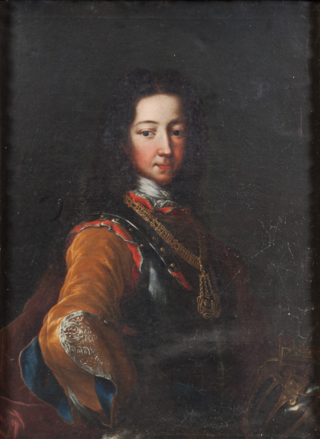
Victor Amadeus II was the head of the House of Savoy and ruler of the Savoyard states from 12 June 1675 until his abdication in 1730. He was the first of his house to acquire a royal crown, ruling first as King of Sicily (1713–1720) and then as King of Sardinia (1720–1730). Among his other titles were Duke of Savoy, Duke of Montferrat, Prince of Piedmont, Marquis of Saluzzo and Count of Aosta, Maurienne and Nice.

Charles Emmanuel III was Duke of Savoy, King of Sardinia and ruler of the Savoyard states from 3 September 1730 until his death in 1773. He was the paternal grandfather of the last three mainline Kings of Sardinia.

Victor Amadeus III was King of Sardinia and ruler of the Savoyard states from 20 February 1773 to his death in 1796. Although he was politically conservative, he carried out numerous administrative reforms until he declared war on Revolutionary France in 1792. He was the father of the last three mainline Kings of Sardinia.

Turin Cathedral is a Roman Catholic cathedral in Turin, northern Italy. Dedicated to Saint John the Baptist. It is the seat of the Archbishops of Turin.

Filippo Juvarra was an Italian architect, scenographer, engraver and goldsmith. He was active in a late-Baroque architecture style, working primarily in Italy, Spain, and Portugal.

The Palazzina di caccia of Stupinigi is one of the Residences of the Royal House of Savoy in northern Italy, part of the UNESCO World Heritage Sites list. Built as a royal hunting lodge in the early 18th century, it is located in Stupinigi, a suburb of the town of Nichelino, 10 km (6 mi) southwest of Turin.

The Royal Palace of Turin is a historic palace of the House of Savoy in the city of Turin in Northern Italy. It was originally built in the 16th century and was later modernized by Christine Marie of France (1606–1663) in the 17th century, with designs by the Baroque architect Filippo Juvarra. The palace also includes the Palazzo Chiablese and the Chapel of the Holy Shroud, the latter of which was built to house the famous Shroud of Turin.

Bernardino Cametti (1669–1736) was an Italian sculptor of the late Baroque.

Superga is a hill situated on the south bank of the river Po to the east of Turin in north-west Italy. At 672 metres (2,205 ft) above sea level, it is one of the most prominent of the hills that ring the city.

Princess Polyxena of Hesse-Rheinfels-Rotenburg was the second wife of Charles Emmanuel, Prince of Piedmont whom she married in 1724. The mother of the future Victor Amadeus III, she was Queen of Sardinia from 1730 until her death in 1735.

The Palace of Venaria is a former royal residence and gardens located in Venaria Reale, near Turin in the Piedmont region in northern Italy. It is one of the Residences of the Royal House of Savoy, included in the UNESCO Heritage List in 1997.

Victor Amadeus of Savoy was the eldest son of Victor Amadeus II, Duke of Savoy and his French wife Anne Marie d'Orléans. He was the heir apparent of Savoy from his birth and as such was styled as the Prince of Piedmont. He acted as Regent of Savoy from September 1713 till September 1714 in the absences of his father. He died of smallpox at the age of 15.

Louis Victor of Savoy, 4th Prince of Carignano headed a cadet branch of the Italian dynasty which reigned over the Kingdom of Sardinia, being known as the Prince of Carignano from 1741 till his death. Upon extinction of the senior line of the family, his great-grandson succeeded to the royal throne as King Charles Albert of Sardinia, while his great-great-grandson, Victor Emmanuel II, became King of Italy.

Princess Maria Felicita of Savoy was a princess of the House of Savoy, the third daughter of Charles Emmanuel III of Sardinia and his second wife, Polyxena of Hesse-Rotenburg.

Italian Baroque architecture refers to Baroque architecture in Italy.

The Kingdom of Sicily was ruled by the House of Savoy from 1713 until 1720, although they lost control of it in 1718 and did not relinquish their title to it until 1723. The only king of Sicily from the House of Savoy was Victor Amadeus II. Throughout this period Sicily remained a distinct realm in personal union with the other Savoyard states, but ultimately it secured for the House of Savoy a royal title and a future of expansion in Italy rather than in France. During this period, the Savoyard monarch used his new title to affirm his sovereign independence.
Maria Elisabetta Carlotta of Savoy was a princess of Savoy by birth, and daughter of King Victor Amadeus III of Savoy and his wife, Maria Antonia Ferdinanda of Spain.
Prince Amadeus Alexander of Savoy, Duke of Montferrat was a member of the Royal House of Savoy. He was an infant son of the king of Sardinia Victor Amadeus III of Savoy and his wife Maria Antonietta of Spain.

The Santuario della Madonna Consolata is a Marian sanctuary and minor basilica in central Turin, Piedmont, Italy. Colloquially, the sanctuary is known as La Consolata. It is located on the intersection of Via Consolata and Via Carlo Ignazio Giulio. The shrine is dedicated to the Blessed Virgin Mary under the title of Our Lady of Consolation.

The Royal Armoury of Turin is one of the world's most important collections of arms and armour, formed in Turin by the Savoy family. The museum is now part of the Musei Reali di Torino, the royal site that has unified the Royal Palace, the Sabauda Gallery, the Archaeological Museum, the Royal Library and the Armoury. The whole site has been included on the UNESCO World Heritage list since 1997.





















